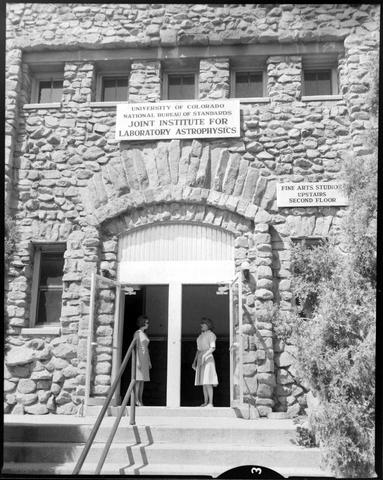
The State Armory Building in Boulder, Colorado, was the first home of JILA, the internationally recognized research establishment celebrating it's 50th anniversary this year.
JILA, a Colorado laboratory known around the world for creating new states of matter and novel laser designs and applications, turns 50 this year and will receive a gratifying anniversary present—designation as an American Physical Society (APS) historic site.
JILA is a collaborative research institution of the National Institute of Standards and Technology (NIST) and the University of Colorado Boulder. JILA will celebrate its 50th anniversary later this week with events that include a formal ceremony on July 13, when the APS designation will be officially announced.
The APS citation honors JILA's achievements in such fields as astrophysics; atomic, molecular and optical physics; biophysics; chemical physics; nanoscience; and precision measurement science.
Established in 1962 as the "Joint Institute for Laboratory Astrophysics," JILA was among the first institutions created as a continuing collaboration between a major government agency and a major university. In the 60s, JILA focused on measurements and analysis to support the burgeoning U.S. space program, but its mission evolved to include much of the frontiers of physics. Today, JILA performs wide-ranging research in lasers, atomic physics, chemical physics, geophysics, semiconductor technology, astrophysics and gravitational and optical physics. As a reflection of this broader mandate, in 1995 JILA dropped its old formal name and became what it was always known as internationally: JILA.
Among their advances, JILA scientists have created the first Bose-Einstein and fermionic condensates; performed laser measurements that led to a more accurate value for the speed of light and the redefinition of the meter; and developed frequency combs, laser-based tools for precisely measuring colors of light, with applications in atomic clocks, astronomy and biomedicine.
JILA joins 22 other APS historic sites, including the original NIST headquarters campus in Washington, D.C. The APS Historic Sites Initiative is described at www.aps.org/programs/outreach/history/historicsites/index.cfm.
Renowned scientists expected to attend this week's anniversary celebration include JILA fellows and Nobel laureates Eric Cornell, John (Jan) Hall and Carl Wieman; founding JILA chair Lewis Branscomb, former director of the National Bureau of Standards (now NIST) and chief scientist at IBM Corp.; and Neal Lane, former presidential science adviser and director of the National Science Foundation.
NIST Director Patrick Gallagher, who is also Under Secretary of Commerce for Standards and Technology, will speak at the July 13 ceremony. Public lectures on JILA history and science are scheduled for June 12. Topics will include personal recollections of Katharine Burr Blodgett, a prominent early American physicist, presented by her niece, Katharine Gebbie, who was JILA's first female fellow and is now director of NIST's Physical Measurement Laboratory.
Read the University of Colorado Boulder news story, "Renowned CU-Boulder/NIST institute celebrates 50 years of scientific advances; named an 'historic physics site'."

